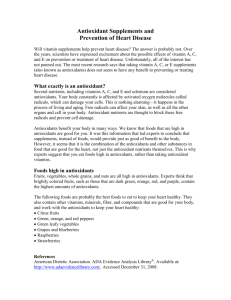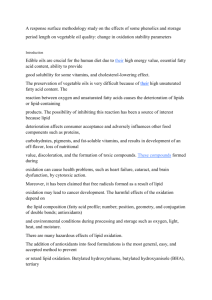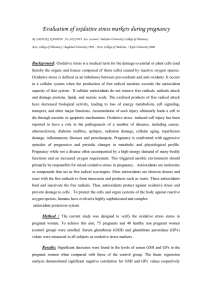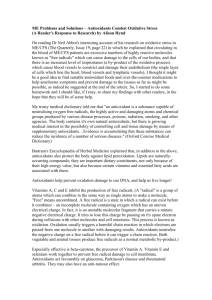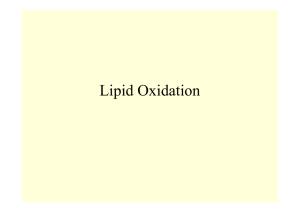Document 13310403
advertisement
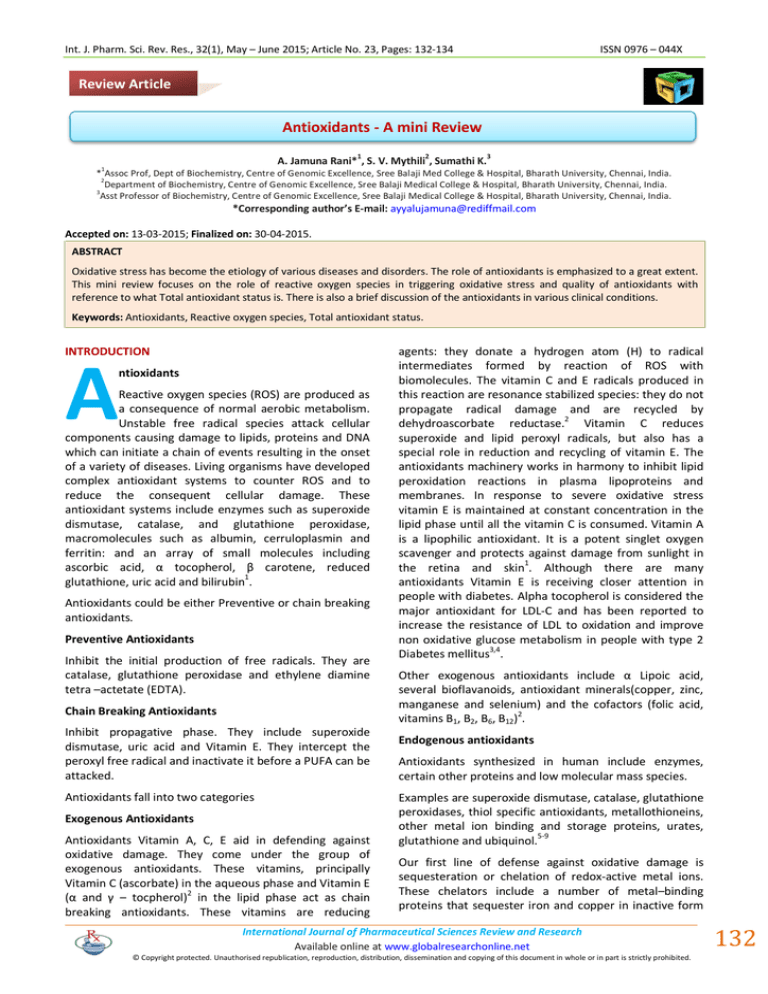
Int. J. Pharm. Sci. Rev. Res., 32(1), May – June 2015; Article No. 23, Pages: 132-134 ISSN 0976 – 044X Review Article Antioxidants - A mini Review 1 2 3 A. Jamuna Rani* , S. V. Mythili , Sumathi K. 1 * Assoc Prof, Dept of Biochemistry, Centre of Genomic Excellence, Sree Balaji Med College & Hospital, Bharath University, Chennai, India. 2 Department of Biochemistry, Centre of Genomic Excellence, Sree Balaji Medical College & Hospital, Bharath University, Chennai, India. 3 Asst Professor of Biochemistry, Centre of Genomic Excellence, Sree Balaji Medical College & Hospital, Bharath University, Chennai, India. *Corresponding author’s E-mail: ayyalujamuna@rediffmail.com Accepted on: 13-03-2015; Finalized on: 30-04-2015. ABSTRACT Oxidative stress has become the etiology of various diseases and disorders. The role of antioxidants is emphasized to a great extent. This mini review focuses on the role of reactive oxygen species in triggering oxidative stress and quality of antioxidants with reference to what Total antioxidant status is. There is also a brief discussion of the antioxidants in various clinical conditions. Keywords: Antioxidants, Reactive oxygen species, Total antioxidant status. INTRODUCTION A ntioxidants Reactive oxygen species (ROS) are produced as a consequence of normal aerobic metabolism. Unstable free radical species attack cellular components causing damage to lipids, proteins and DNA which can initiate a chain of events resulting in the onset of a variety of diseases. Living organisms have developed complex antioxidant systems to counter ROS and to reduce the consequent cellular damage. These antioxidant systems include enzymes such as superoxide dismutase, catalase, and glutathione peroxidase, macromolecules such as albumin, cerruloplasmin and ferritin: and an array of small molecules including ascorbic acid, α tocopherol, β carotene, reduced glutathione, uric acid and bilirubin1. Antioxidants could be either Preventive or chain breaking antioxidants. Preventive Antioxidants Inhibit the initial production of free radicals. They are catalase, glutathione peroxidase and ethylene diamine tetra –actetate (EDTA). Chain Breaking Antioxidants Inhibit propagative phase. They include superoxide dismutase, uric acid and Vitamin E. They intercept the peroxyl free radical and inactivate it before a PUFA can be attacked. Antioxidants fall into two categories Exogenous Antioxidants Antioxidants Vitamin A, C, E aid in defending against oxidative damage. They come under the group of exogenous antioxidants. These vitamins, principally Vitamin C (ascorbate) in the aqueous phase and Vitamin E (α and γ – tocpherol)2 in the lipid phase act as chain breaking antioxidants. These vitamins are reducing agents: they donate a hydrogen atom (H) to radical intermediates formed by reaction of ROS with biomolecules. The vitamin C and E radicals produced in this reaction are resonance stabilized species: they do not propagate radical damage and are recycled by dehydroascorbate reductase.2 Vitamin C reduces superoxide and lipid peroxyl radicals, but also has a special role in reduction and recycling of vitamin E. The antioxidants machinery works in harmony to inhibit lipid peroxidation reactions in plasma lipoproteins and membranes. In response to severe oxidative stress vitamin E is maintained at constant concentration in the lipid phase until all the vitamin C is consumed. Vitamin A is a lipophilic antioxidant. It is a potent singlet oxygen scavenger and protects against damage from sunlight in the retina and skin1. Although there are many antioxidants Vitamin E is receiving closer attention in people with diabetes. Alpha tocopherol is considered the major antioxidant for LDL-C and has been reported to increase the resistance of LDL to oxidation and improve non oxidative glucose metabolism in people with type 2 3,4 Diabetes mellitus . Other exogenous antioxidants include α Lipoic acid, several bioflavanoids, antioxidant minerals(copper, zinc, manganese and selenium) and the cofactors (folic acid, vitamins B1, B2, B6, B12)2. Endogenous antioxidants Antioxidants synthesized in human include enzymes, certain other proteins and low molecular mass species. Examples are superoxide dismutase, catalase, glutathione peroxidases, thiol specific antioxidants, metallothioneins, other metal ion binding and storage proteins, urates, glutathione and ubiquinol.5-9 Our first line of defense against oxidative damage is sequesteration or chelation of redox-active metal ions. These chelators include a number of metal–binding proteins that sequester iron and copper in inactive form International Journal of Pharmaceutical Sciences Review and Research Available online at www.globalresearchonline.net © Copyright protected. Unauthorised republication, reproduction, distribution, dissemination and copying of this document in whole or in part is strictly prohibited. 132 © Copyright pro Int. J. Pharm. Sci. Rev. Res., 32(1), May – June 2015; Article No. 23, Pages: 132-134 such as transferin and ferritin. Hemopexin binds heme, a lipid soluble form of iron, which catalyzes ROS formation in lipid environments: it delivers the heme to the liver for catabolism. Haptoglobin binds to hemoglobin and decreases the pro oxidant activity of hemoglobin molecule. Haptoglobin later delivers hemoglobin to the liver for catabolism.2 Albumin, the major plasma protein, has a strong binding site for copper and effectively inhibits copper catalyzed 2 oxidation reactions in plasma. Carnosine (β alanyl-L-histidine) is present in muscle and brain at millimolar concentration. They are potent copper chelators and play a role in intracellular antioxidant protection. Superoxide dismutase Superoxide dismutases (SOD) are a class of closely related enzymes present in almost all aerobic cells and in extracellular fluid catalyzing the breakdown of superoxide anion into oxygen and hydrogen peroxide. SOD present in the cytosol has copper/zinc, while the mitochondrial SOD has manganese. The third form in the extracellular fluid has copper and zinc in its active sites.2 Catalase Catalyzes the conversion of hydrogen peroxide to water and oxygen, using iron or manganese as cofactor. This enzyme is localized in peroxisomes. Catalase has a peculiar ping pong mechanism of action on its only substrate whereby its cofactor is oxidized by one molecule of hydrogen peroxide and then regenerated by transferring the bound oxygen to a second molecule of substrate10. Peroxidases Glutathione peroxidase is widely distributed in the cytosol, in the mitochondria and in the nucleus. It reduces both hydrogen peroxide and lipid hydroperoxides to water and a lipid alcohol. It requires Glutathione as a co substrate. Glutathione Glutathione functions as a direct free radical scavenger as a co substrate for glutathione peroxidase activity and as a cofactor for many enzymes, and forms conjugates in endo and xenobiotic reactions. Glutathione Peroxidase and reductase are two enzymes that are present in cytoplasm, mitochondria and nucleus. Glutathione Peroxidase metabolizes hydrogen peroxide to water by using reduced glutathione as a hydrogen donor. Glutathione disulfide is recycled back to glutathione by glutathione reductase, using NADPH generated by glucose 6 phosphate dehydrogenase of the Hexose Monophosphate Shunt Pathway11,12. Melatonin: Melatonin is an endogenously produced powerful antioxidant that can cross blood brain barrier. Melatonin once oxidized, cannot be reduced to its former ISSN 0976 – 044X state because it forms several stable end products on reacting with free radicals. It is a terminal antioxidant.13 Uric Acid The ability of urate to scavenge oxygen radicals and protect the erythrocyte membrane from Lipid oxidation was originally described by Kellogg and Fridovich14 and was characterized further by Amesl.15 In the above studies the effects of uric acid was shown under specific conditions where exogenously added uric acid protected cells from oxidants, which were also added exogenously to aqueous incubation media. This kind of condition is relevant to a variety of physiological situations when circulating uric acid can scavenge reactive radicals released into the blood by deleterious reactions, such as autoxidation of hemoglobin or peroxide production by 15 macrophages. According to a popular hypothesis in the early eighties by Ames15 the silencing of the uricase gene with an increase in the blood level of uric acid provided an evolutionary advantage for ancestors of Humans. This hypothesis was based on in vitro experiments which showed that uric acid is a powerful scavenger of singlet oxygen, peroxyl radicals (RO2) and hydroxyl radicals (OH). Urate circulating in elevated concentrations was proposed to be one of the major antioxidants of the plasma that protects cells from oxidative damage, thereby contributing to an increase in life span of our species and decreasing the risk for cancer. In the plasma urate can prevent lipid peroxidation only as long as Vitamin C is present.16 Uric acid is an antioxidant only in the hydrophilic environment, which is probably a major limitation of the antioxidant function of uric acid. On the other hand, a vast literature on the epidemiology of cardiovascular disease, hypertension, and metabolic syndrome overwhelmingly shows that, at least among modern Humans, a high level of uric acid is strongly related and in many cases alarms development of hypertension17-19 visceral obesity,20-22 insulin resistance,23 dyslipidemia,20,23,24,25 type II diabetes,24 kidney disease,18 and cardiovascular and cerebrovascular events.18,26 Coenzyme Q10 is a potent antioxidant. Antioxidant Co Q10 has proven to have protective function especially in 27 heart. Apart from the above broad spectrum of antioxidants, there is also a HDL associated PON 1 enzyme with antioxidant properties. Studies across the globe show evidence of the prevention of LDL and HDL oxidation by PON 1.28 In fact, previous studies have shown that PON1 is able to hydrolyze preformed lipid hydroperoxides and to delay or inhibit the initiation of oxidation induced by 29,30 metal ions on lipoproteins. REFERENCES 1. Barry Halliwell - Oxidative stress, Nutrition and Health. Experimental strategies for optimization of Nutritional Antioxidant intake in humans.Free Rad Rev., 25(1), 57-74. 2. Baynes, John W, Marek H. Dominiczak. Medical Biochemistry 2nd. Edition. Elsevier Mosby.2005, 477. International Journal of Pharmaceutical Sciences Review and Research Available online at www.globalresearchonline.net © Copyright protected. Unauthorised republication, reproduction, distribution, dissemination and copying of this document in whole or in part is strictly prohibited. 133 © Copyright pro Int. J. Pharm. Sci. Rev. Res., 32(1), May – June 2015; Article No. 23, Pages: 132-134 3. Cereillo A, Giugliano D, Quatraro A and Donzella C. Vitamin E reduction of protein glycosylation in in diabetes, a new prospect for prevention of diabetic complication? Diabetic care. 14, 1991, 68-72. 4. Fridovich. Superoxide dismutases. Adv Enzymol Relat Areas Mol Biol. 58, 1986, 61–97. 5. Benoît D’Autréaux and Michel B. Toledano.ROS as signaling molecules: mechanisms that generate specificity in ROS homeostasis. Nature reviews molecular cell biology. 8, 2007, 813-824. 6. B. Chance, H. Sies and A. Boveris. Hydroperoxide metabolism in mammalian organs. Physiological reviews. 59, 1979, 527-605. 7. H. Sies. Oxidative stress: oxidants and antioxidants. Academic Press, London and New York. 1991, 15-23. 8. B. Frei. Natural antioxidants in Human health and disease, Academic Press, San Diego. 1994. 9. B. Halliwell and J. MC. Gutteridge. The antioxidants of Human extracellular fluids. Archives of Biochemistry and Biophysics, 280, 1990, 1-8. 10. Winterbourn CC. Superoxide as an intracellular radical sink. Free Radic Biol Med, 14, 1993, 85-90. 11. Sies H. Damage to plasmid DNA by singlet oxygen and its protection. Mut Res. 299, 1993, 183-191. 12. Valko M, Izakovic M, Mazur M and Rhodes C Role of oxygen radicals in DNA damage and cancer incidence. Mol Cell Biochem. 266(1-2), 2004, 37-56. 13. Reiter RJ, Carneiro RC, Oh CS. Melatonin in relation to cellular antioxidative defence mechanism. Horm.Metab.Res. 29(8), 1997, 363-372. 14. Kellogg EW 3rd, Fridovich I. Liposome oxidation and erythrocyte lysis by enzymically generated superoxide and hydrogen peroxide. J Biol Chem. 252, 1977, 6721–6728. ISSN 0976 – 044X 19. Johnson RJ, Segal MS, Srinivas T and Ejaz A Essential hypertension, progressive renal disease, and uric acid: a pathogenetic link? J Am Soc Nephrol. 16, 2005, 1909–1919. 20. Bonora E, Targher G, Zenere MB and Saggiani F Relationship of uric acid concentration to cardiovascular risk factors in young men. Role of obesity and central fat distribution. The Verona Young Men Atherosclerosis Risk Factors Study. Int J Obes Relat Metab Disord. 20, 1996, 975–980. 21. Masuo K, Kawaguchi H, Mikami H and Ogihara T Serum uric acid and plasma norepinephrine concentrations predict subsequent weight gain and blood pressure elevation. Hypertension. 42, 2003, 474–480. 22. Ogura T, Matsuura K, Matsumoto Y and Mimura Y Recent trends of hyperuricemia and obesity in Japanese male adolescents 1991 through 2002. Metabolism. 53, 2004, 448–453. 23. Nakanishi N, Okamoto M, Yoshida H and Matsuo Y Serum uric acid and risk for development of hypertension and impaired fasting glucose or Type II diabetes in Japanese male office workers. Eur J Epidemiol. 18, 2003, 523–530. 24. Zavaroni I, Mazza S, Fantuzzi M, Dall’Aglio E, Bonora E and Delsignore Changes in insulin and lipid metabolism in males with asymptomatic hyperuricaemia. J Intern Med. 234, 1993, 25–30. 25. Matsubara M, Chiba H, Maruoka S, Katayose S. Elevated serum leptin concentrations in women with hyperuricemia. J Atheroscler Thromb, 9, 2002, 28–34. [PubMed: 12238635] 26. Alderman MH, Cohen H, Madhavan S, Kivlighn S. Serum uric acid and cardiovascular events in successfully treated hypertensive patients. Hypertension. 34, 1999, 144–150. 27. Turunen M, Olsson J, Dallner G. Metabolism and fuction of Co Q. Biochem Biophys Acta. 1660(1-2), 2004, 171-199. 15. Ames BN, Cathcart R, Schwiers E, Hochstein P. Uric acid provides an antioxidant defense in humans against oxidantand radical-caused aging and cancer: a hypothesis. Proc Natl Acad Sci USA. 78, 1981, 6858–6862. 28. Karabina SA, Lehner AN, Franke E and Parthasarathy S Oxidative inactivation of paraoxonase—implications in diabetes mellitus and atherosclerosis. Biochem Biophys Acta. 1725, 2005, 213-221. 16. Frei B, Stocker R, Ames BN. Antioxidant defenses and lipid peroxidation in human blood plasma. Proc Natl Acad Sci USA. 85, 1988, 9748–9752. 29. Bulent Sozmen, Yasemin Delen, Ferhan K and GirgiCatalase and paraoxonase in hypertensive type 2 Diabetic Mellitus. Correlation with glycemic control. Clinical biochemistry. 32, 1999, 423-427. 17. Alper AB Jr, Chen W, Yau L and Srinivasan SR Childhood uric acid predicts adult blood pressure: the Bogalusa Heart Study. Hypertension. 45, 2005, 34–38. 18. Johnson RJ, Kang DH, Feig D and Kivlighn S. Is there a pathogenetic role for uric acid in hypertension and cardiovascular and renal disease? Hypertension. 41, 2003, 1183–1190. 30. Michael Aviram, Mira Rosenblat, Scott Billecke and John Erogul - Human PON1 is inactivated by oxidized LDL and preserved by a antioxidants. Free radical biology medicine. 26, 1999, 892-904. Source of Support: Nil, Conflict of Interest: None. International Journal of Pharmaceutical Sciences Review and Research Available online at www.globalresearchonline.net © Copyright protected. Unauthorised republication, reproduction, distribution, dissemination and copying of this document in whole or in part is strictly prohibited. 134 © Copyright pro

